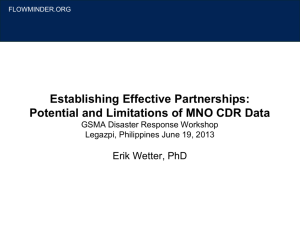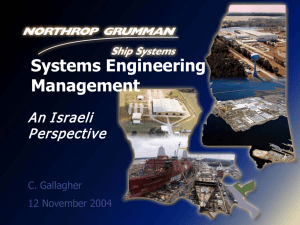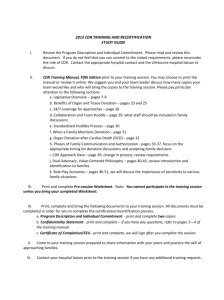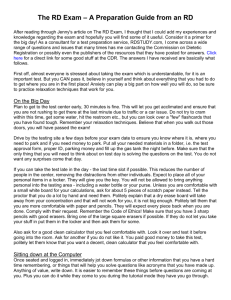LRO Instrument CDRs
advertisement
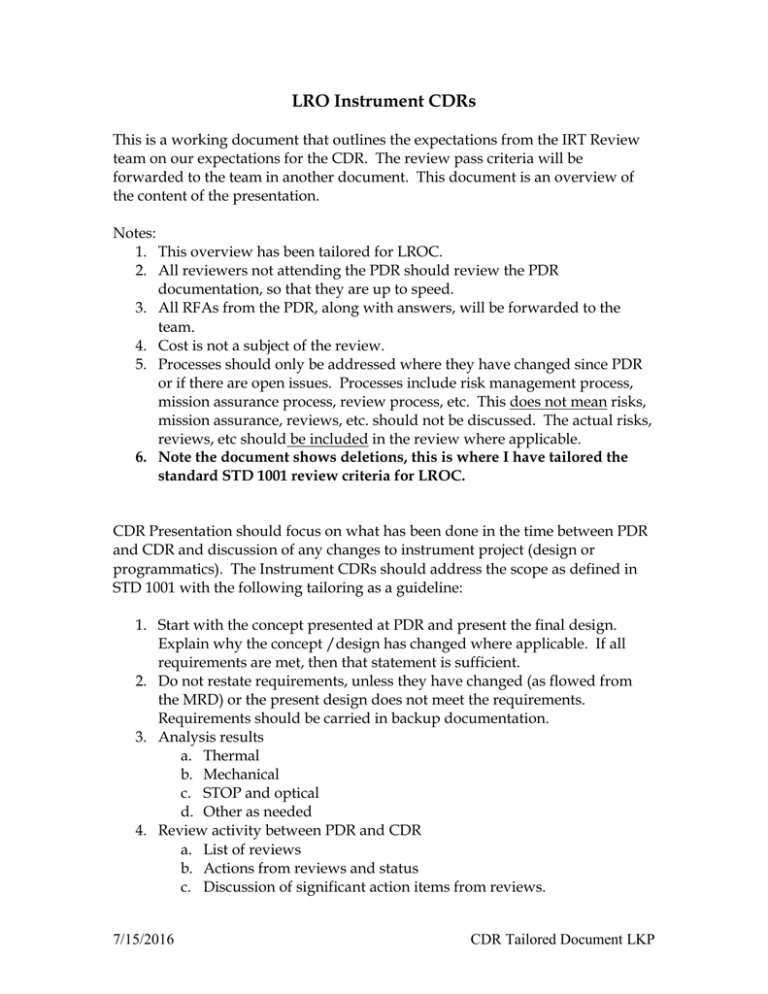
LRO Instrument CDRs This is a working document that outlines the expectations from the IRT Review team on our expectations for the CDR. The review pass criteria will be forwarded to the team in another document. This document is an overview of the content of the presentation. Notes: 1. This overview has been tailored for LROC. 2. All reviewers not attending the PDR should review the PDR documentation, so that they are up to speed. 3. All RFAs from the PDR, along with answers, will be forwarded to the team. 4. Cost is not a subject of the review. 5. Processes should only be addressed where they have changed since PDR or if there are open issues. Processes include risk management process, mission assurance process, review process, etc. This does not mean risks, mission assurance, reviews, etc. should not be discussed. The actual risks, reviews, etc should be included in the review where applicable. 6. Note the document shows deletions, this is where I have tailored the standard STD 1001 review criteria for LROC. CDR Presentation should focus on what has been done in the time between PDR and CDR and discussion of any changes to instrument project (design or programmatics). The Instrument CDRs should address the scope as defined in STD 1001 with the following tailoring as a guideline: 1. Start with the concept presented at PDR and present the final design. Explain why the concept /design has changed where applicable. If all requirements are met, then that statement is sufficient. 2. Do not restate requirements, unless they have changed (as flowed from the MRD) or the present design does not meet the requirements. Requirements should be carried in backup documentation. 3. Analysis results a. Thermal b. Mechanical c. STOP and optical d. Other as needed 4. Review activity between PDR and CDR a. List of reviews b. Actions from reviews and status c. Discussion of significant action items from reviews. 7/15/2016 CDR Tailored Document LKP 5. 6. 7. 8. d. Provide backup copy of review packages, actions and closure in case team wants to read. Present documentation status a. Interfaces should be presented in terms of compliance with documents. I/F documents should be provided as a backup, hard copy in the back of the room. b. Mission assurance c. Safety d. V&V Integration and Test a. Plan overview (what are you testing when) b. V&V (can you verify all your requirements) Schedule a. Schedule overview showing how you fit in the overall project schedule. At the end of the presentation the IRT should be able to make an assessment as to whether you will make your schedule. Therefore, you should present why you think you will make your schedule. b. Deliverables (thermal models, mechanical models, etc, also list what is expected from LRO (S/C simulators, documents, etc) c. Please show what your baseline is, and how you are doing against that schedule. This is usually done in terms of a start/stop and progress against that schedule so that we can see if you are behind, ahead or on schedule. A list of milestone it not sufficient. d. Status of critical procurements and how they fit in schedule. “Day in the Life of LROC”. This is a summary particular to GSFC. It shows what the LROC team will be doing on operations. It illustrates what requirements you have levied on LRO, what they have levied on you, how you are setting up data passes, how you are processing data, etc. We should be able to get an example for you. CDR Objectives from STD 1001 Note that this is the STD requirements and I have tailored for LROC, all text in blue or red denotes tailoring. The objectives of the CDR are to demonstrate that: (a) all elements of the design are compliant with functional and performance requirements, (b) the verification approach is viable and will confirm compliance with all requirements, (c) risks have been appropriately identified and mitigated or are on track for timely mitigation, (d) the design is sufficiently mature to proceed with full scale fabrication, (e) the management processes used by the project team are sufficient 7/15/2016 CDR Tailored Document LKP to develop and operate the mission (this should be evident by what you present with respect to schedule, risks, reviews, etc. not a description of processes) , and (f) the schedules indicate that the mission will be ready to launch and operate on time and and that the control processes (again, evident by what you present with respect to schedule, risk, reviews, etc, not a description of processes) are adequate to ensure remaining within allocated resources. The CDR should represent a complete presentation of the entire final design. It should present the final design and interfaces by means of, block diagrams, power flow diagrams, signal flow diagrams, software logic flowor state diagrams , modeling results, and breadboard and engineering model status and test results. Traceability for all items specified for previous IIRT reviews, updated to the present stage of the development process, should be presented. . Specifically, the areas listed below shall be addressed in sufficient detail to permit a judgment by the IIRT regarding accomplishment of review objectives. That judgment will be guided by attainment of the expectations delineated in the following section: a. Design Description Evolution and b. Total System Performance (budgets/projections/margins for combined optical, thermal, mechanical, control, etc.) c. Design Analyses list analysis completed, present critical analysis (i.e. thermal, STOP, mechanical) Note that this is not a peer review, do not present in that detail. d. Development Test Activities and status e. Risk Management: presentation at PDR was excellent, it showed risks, and evolution of risks. This is the model that I wish every one would use. We want to understand what are your current risks, and what are the mitigation plans. f. Safety: provide status of document g. Assurance Activities: Provide status, if contractors must adhere to Mission Assurance requirements, provide status and issues if any. h. Implementation Plans i. Qualification/Environmental Test Plans and Test Flow: in what ever detail you have. It is important that you have agreed on qualification, and you have a verification plan so that you can state that you can verify all your requirements. j. Interface Control Documents: status of documents k. Science should be covered as part of the day in the life unless there are changes. Restatement of science objectives should not be included. 7/15/2016 CDR Tailored Document LKP l. m. Project and Independent Review Activity Peer reviews, technical reviews for subcontractors. 7/15/2016 CDR Tailored Document LKP
